Rain has a profound impact on all the landscapes it graces. It gives life to plants and communities alike. But there exists a particular corner of the world that stands out as the ultimate receiver of rainfall. Colombia boasts a landscape as diverse as its rich cultural heritage. But what truly sets this nation apart is its distinction as the rainiest place on Earth. From the lush Amazon rainforest in the country to its stunning coastal regions, Colombia’s abundant rain shapes its ecosystems, cultures, and way of life.
Colombia’s weather
The country’s proximity to the equator, its varying topography, and its multiple ecosystems contribute to a wide range of climates that can change dramatically even within short distances. From the steamy rainforests of the Amazon basin to the cool highlands of the Andes Mountains, Colombia contains different biomes that captivate both locals and visitors alike.
One of the most significant factors shaping Colombia’s weather is the interplay between its two distinct rainy seasons and two dry seasons. The rainy seasons typically occur from April to May and from October to November. These periods bring abundant rainfall, which is crucial for sustaining agriculture and ecosystems. The dry seasons occur from December to March and from June to August. During these times, many regions experience drier and warmer conditions. However, Colombia’s weather is anything but uniform. This is because microclimates emerge due to elevation changes, proximity to the ocean, and other geographical features.
While Colombia generally enjoys a tropical climate, the variations are significant. For instance, the city of Bogotá, situated at an elevation of over 2,600 meters (8,500 feet), experiences relatively mild temperatures year-round due to its high altitude. In contrast, coastal cities like Cartagena, located at sea level, have a tropical climate with warm temperatures and high humidity.
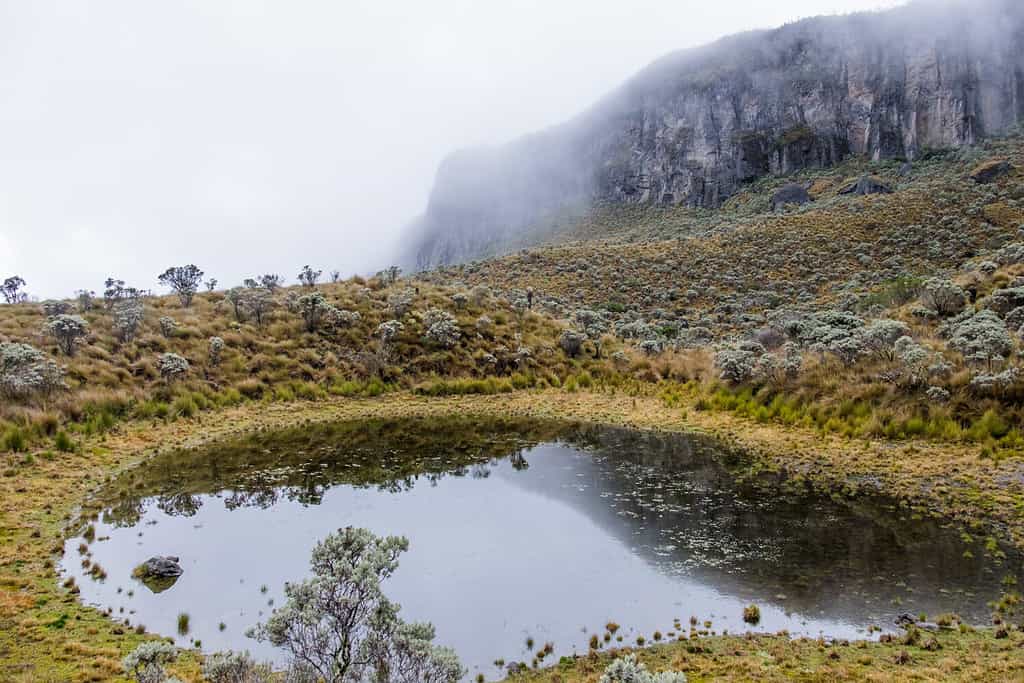
Colombia is one of the wettest places on the planet, but not every part of the country receives a lot of rain.
©Antoine Barthelemy/Shutterstock.com
Colombia’s Rainfall Records
Colombia’s reputation as the rainiest place on Earth is no exaggeration. With an annual average precipitation of around 120 inches (3,048 millimeters), the country is a true wet zone. This abundant rainfall is attributed to multiple factors. This includes its geographical location, as it is situated between the Pacific Ocean and the Caribbean Sea. Also, the presence of the Andes Mountains creates an orographic effect, enhancing the precipitation in certain areas.
Colombia has witnessed both the wonders and challenges associated with heavy rainfall. The country has faced devastating floods, landslides, and mudslides during intense rainy seasons. This often leads to loss of life and property damage. However, heavy rainfall is also a source of life and fertility for Colombia’s lush landscapes. Rainfall records vary significantly across regions, with areas like the Chocó department experiencing some of the highest annual rainfall totals in the world. However, arid regions like the Guajira Peninsula can simultaneously face water scarcity.
The Amazon Rainforest: A Verdant Oasis
At the heart of Colombia lies the Amazon rainforest, an awe-inspiring expanse of biodiversity and verdant beauty. This region receives great amounts of rainfall and nurtures a staggering variety of plant and animal species. Colombia’s Amazon basin, which encompasses a significant portion of the country, is a vital part of the planet’s lungs. It contributes heavily to global climate regulation. The rainforest also serves as a cradle of life, hosting unique flora and fauna found nowhere else on Earth.
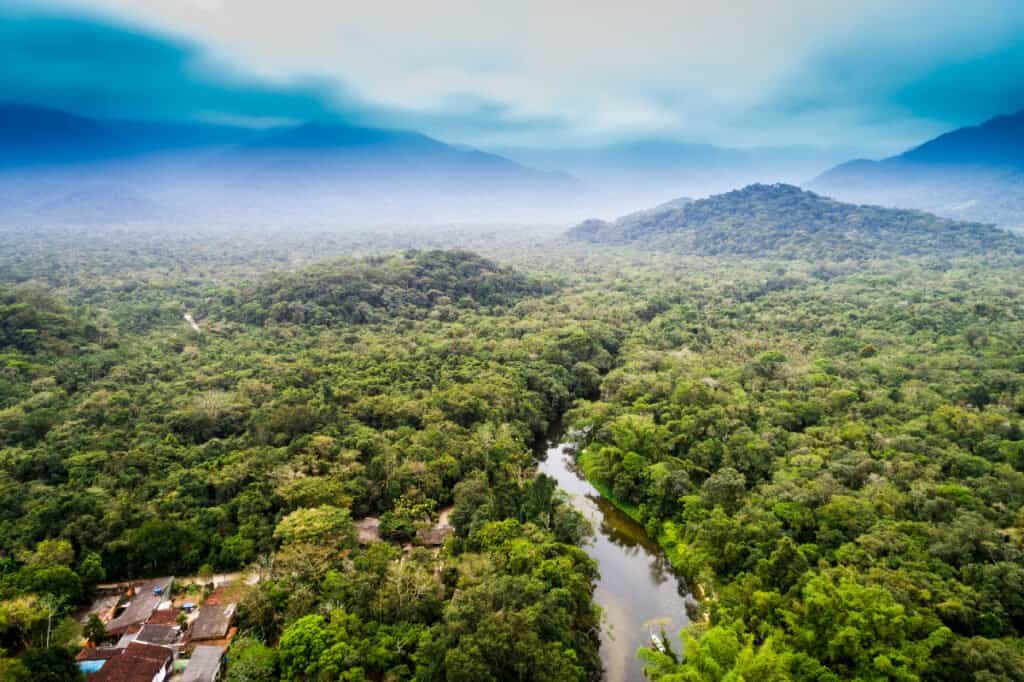
The Amazon River in Colombia has incredible biodiversity and plays a vital role in the surrounding ecosystem.
©iStock.com/gustavofrazao
The Chocó: A Rain-Drenched Paradise
Situated along the Pacific coast, the lush and rain-drenched country is renowned for its extraordinary levels of rainfall. The Chocó, which has shorelines on both the Pacific and the Atlantic, is the wettest place on Earth. The Chocó boasts an average annual precipitation of around 400 inches (10,160 millimeters), which is a staggering amount that shapes the landscapes, ecosystems, and way of life of the communities that call it home.
The Chocó’s dense rainforests, mangroves, and rivers also flourish under the influence of the abundant rainfall. These ecosystems support an unparalleled variety of flora and fauna, making it a hotspot for biodiversity. The lush vegetation provides habitat for countless species, from rare amphibians and insects to elusive mammals and vibrant birdlife. The Chocó’s waters are teeming with life, hosting various fish species, crustaceans, and even the endangered humpback whales that migrate to its shores.
Amidst this natural splendor, the Chocó is also home to diverse indigenous and Afro-Colombian communities. These communities have developed deep relationships with the land and water, which have shaped their traditions, languages, and ways of life. The Chocó’s rich cultural heritage is therefore a testament to the enduring bond between its people and the natural world.
Biodiversity in Chocó
The Chocó’s biodiversity and cultural richness face challenges. The region’s isolated nature has made it vulnerable to illegal activities such as logging and mining, which threaten its delicate ecosystems. Climate change also poses risks, as changing weather patterns can impact the delicate balance of the Chocó’s ecosystems.
Several efforts are underway to protect and preserve the Chocó’s invaluable resources. Conservation organizations, local communities, as well as governmental authorities are working collaboratively to safeguard the region’s biodiversity and support sustainable livelihoods for its inhabitants. Ecotourism has emerged as a means of gaining traction in preserving the environment and providing economic opportunities for local communities.
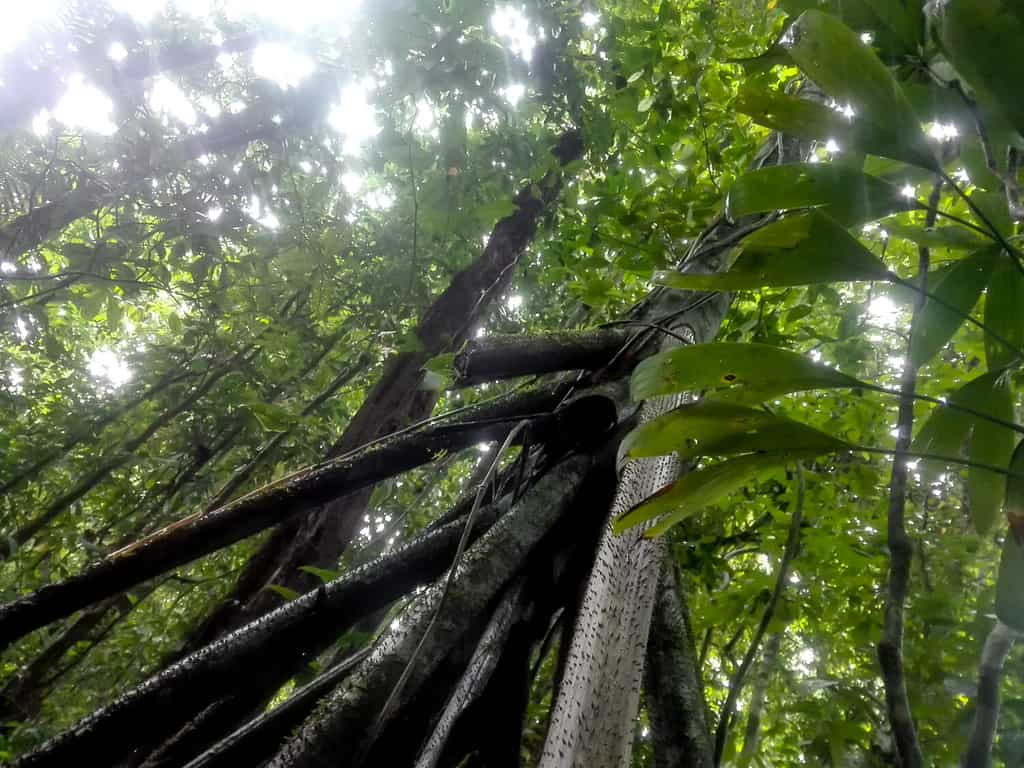
Huacrapona palm tree lives across a wide range of South America, including the Chocó department in Colombia.
©The beauty of the world/Shutterstock.com
Cultural Resilience and Rain’s Influence on Traditions
Colombia’s abundant rainfall has also influenced its cultural practices and traditions. Indigenous communities in regions like the Amazon and Chocó have developed close relationships with the land and water, incorporating rain-centric rituals into their way of life.
Rain: A Life-Giving Force
The rain is more than just a meteorological phenomenon in Colombia; it’s a life-giving force that sustains ecosystems, agriculture, and human settlements. The country’s diverse geography, which ranges from tropical rainforests to high-altitude mountains, ensures that different regions experience distinct rainy seasons. These seasons also influence the rhythm of life for Colombians, dictating planting and harvest times, shaping daily routines, and even inspiring cultural celebrations.
Traditional Agriculture and Rain Rituals
Colombia’s agricultural practices have long evolved in harmony with the rains. Indigenous communities and rural populations have developed intricate knowledge of rain patterns, allowing them to optimize crop yields. The arrival of rains also marks the start of planting season, and the cessation signals the time for harvesting. This intricate dance with the rain has given rise to cultural rituals that celebrate the generous spirit of nature. In many indigenous cultures, rain dances and ceremonies are performed to honor the rain spirits, as communities seek favor for bountiful harvests. These rituals not only reflect reverence for nature but also demonstrate the wisdom of adapting to environmental changes.

Rain creates beautiful rainforests across Colombia that provide nutrition and medicinal goods for the rest of the world.
©Gergo Nagy/Shutterstock.com
Cultural Festivals: Celebrating Rain’s Bounty
Throughout Colombia, people organize several rain-related festivals where they celebrate the bounty that rain brings to the land. One notable example is the “Dia de San Pedro,” which is celebrated in the Caribbean coastal region of San Andrés, Providencia, and Santa Catalina. This festival marks the transition from the dry season to the rainy season. It recognizes the vital role rain plays in replenishing water sources, supporting fishing, and fostering agricultural growth. To celebrate, locals gather to dance, sing, and offer gratitude for the arrival of rain, reinforcing the connection between culture, nature, and community.
Environmental Impact: Balancing Abundance and Challenges
While abundant rainfall supports lush ecosystems and sustains agriculture, it also brings challenges. Landslides and flooding can occur during intense rainstorms, posing risks to communities and infrastructure. Deforestation and improper land use also exacerbate these issues.
Ecotourism and Biodiversity Exploration
Colombia’s rich biodiversity, fueled by its rainfall, has caught the attention of eco-tourists and nature enthusiasts. From birdwatching to trekking through rainforests and exploring unique ecosystems, visitors are drawn to Colombia’s remarkable landscapes. The country’s diverse climates, influenced by its abundant rainfall, offer travelers a chance to experience various ecosystems and habitats.
The Impact of Climate Change
In recent years, Colombia, like many other parts of the world, has experienced the effects of climate change, which has altered traditional rain patterns and brought about irregular weather events. These changes pose both challenges and opportunities. Indigenous communities and local traditions have demonstrated adaptability by integrating modern weather forecasting techniques with their ancestral knowledge. For example, some communities collaborate with meteorologists to better predict rainfall, allowing for more effective crop planning and disaster preparedness.

Numerous animals live in the wettest regions of Colombia, including eagles.
©jeremaixs/Shutterstock.com
Colombia’s Wildlife Tapestry: A Biodiversity Marvel
Colombia’s diverse landscapes, ranging from lush rainforests to rugged mountains and coastal plains, harbor an astonishing array of wildlife. The country is privileged to have different ecosystems and status as one of the most biodiverse nations on Earth. From the treetops of the Amazon to the depths of its oceans, Colombia’s wildlife showcases nature’s boundless creativity and adaptation.
Amazon Rainforest: A Biodiversity Hotspot
Colombia’s portion of the Amazon rainforest is a biodiversity hotspot of global significance. This dense expanse of lush vegetation teems with an incredible variety of species, many of which are found nowhere else on the planet. The Amazon is home to jaguars, tapirs, capybaras, giant river otters, and an astonishing diversity of bird species. Scarlet macaws, toucans, and harpy eagles grace the skies, while pink river dolphins and caimans navigate the waterways.
Andean Cloud Forests: A World Above the Clouds
The Andes Mountains, which cut across Colombia, house unique ecosystems known as cloud forests. These mist-shrouded realms are home to diverse creatures adapted to cooler temperatures and higher altitudes. The Andean spectacled bear, the only bear species in South America, roams these forests, alongside species like the mountain tapir and Andean condor. Orchids, bromeliads, and mosses also thrive in this surreal environment, adding to its ethereal beauty.
Coastal Marvels: From Mangroves to Coral Reefs
Colombia’s extensive coastline and marine environments harbor their own wealth of biodiversity. Mangroves along the coast provide crucial nurseries for various fish species, and the sea turtle nesting sites draw global attention. The vibrant coral reefs of the San Andres and Providencia archipelagos support an array of marine life, including colorful fish, rays, and sharks.
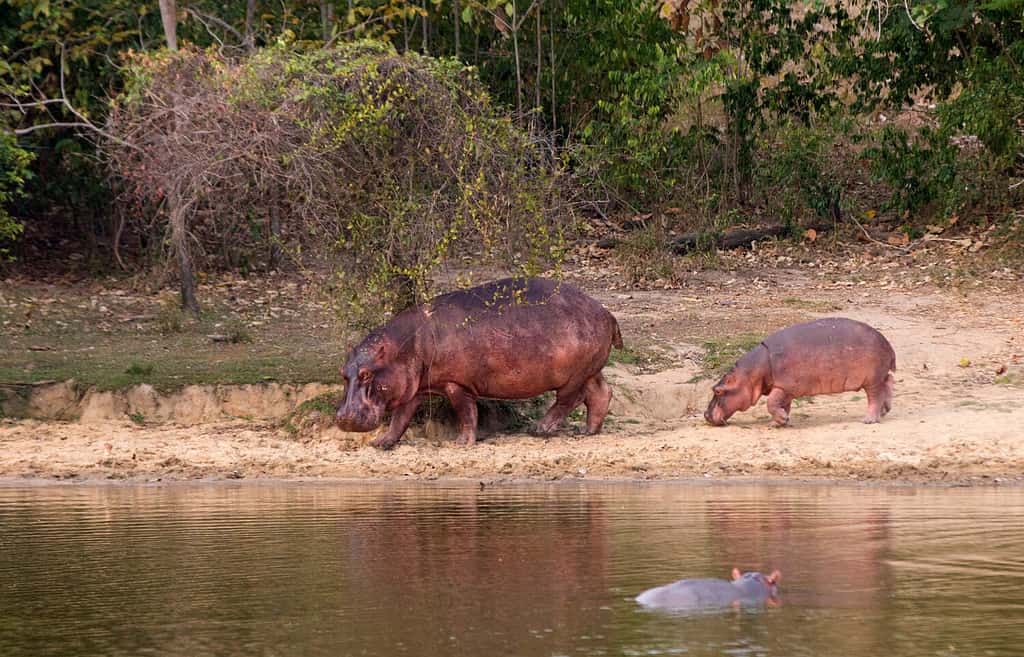
Colombia is also home to unique species of
hippopotamus
that benefit because of the rainy weather.
©Guillermo Ossa/Shutterstock.com
High Plateaus: Unique Flora and Fauna Adaptations
The high plateaus of Colombia, known as páramos, are unique ecosystems found at high altitudes. Despite the challenging conditions, these areas are home to remarkable adaptations. The endangered mountain tapir roams here, along with a variety of hummingbirds, frogs, and the elusive Andean condor. Páramos also play a vital role in maintaining water resources, making them ecologically indispensable.
Conservation Efforts and Challenges
While Colombia’s wildlife is awe-inspiring, it also faces various threats. Deforestation, habitat loss, illegal wildlife trade, and climate change all put pressure on the country’s delicate ecosystems. Fortunately, conservation efforts are on the rise. Organizations and local communities are working together to protect vital habitats, rehabilitate injured animals, and educate the public about the importance of biodiversity.
Ecotourism and Responsible Exploration
Colombia’s extraordinary wildlife has not gone unnoticed by ecotourists and nature enthusiasts. Responsible ecotourism offers visitors the chance to explore the country’s landscapes while contributing to conservation efforts. Guided tours through rainforests, birdwatching expeditions, and underwater explorations of coral reefs allow travelers to connect with Colombia’s natural wonders in a sustainable manner.
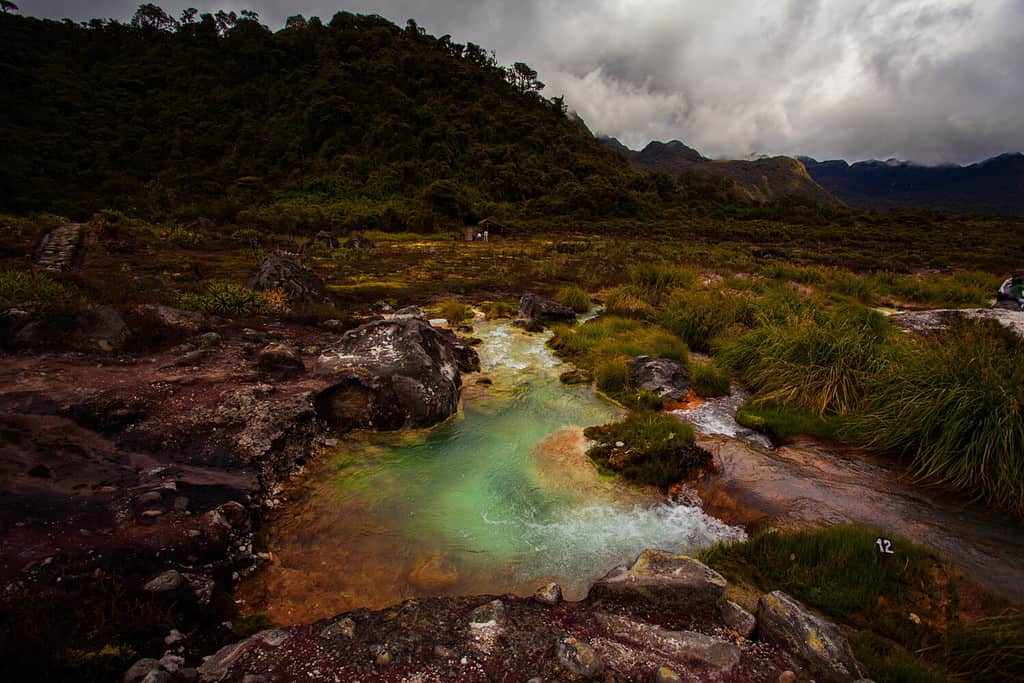
These unique geographical and weather conditions in Colombia bring a lot of visitors, who can help protect the rainforest.
©Guillermo Ossa/Shutterstock.com
The Legacy of Rain
Colombia’s unique relationship with rainfall showcases the symbiotic connection between nature and culture. The country’s lush rainforests, vibrant traditions, and environmental challenges are all intertwined with the ebb and flow of precipitation. Embracing this abundance while addressing its challenges has become a vital part of Colombia’s journey toward sustainability, resilience, and harmonious coexistence with the elements.
Colombia’s distinction as one of the rainiest places on Earth is not just a meteorological fact; it’s a cornerstone of its identity. Rainfall shapes the country’s ecosystems, cultures, and daily life. From the Amazon rainforest to the vibrant communities of the Chocó region, Colombia’s abundant rainfall creates a dynamic environment, connecting its people to the land and fostering an enduring appreciation for the beauty and power of nature.
The photo featured at the top of this post is © Cristian Gonzalez Acosta/Shutterstock.com
Thank you for reading! Have some feedback for us? Contact the AZ Animals editorial team.






